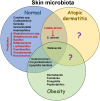Obesity and the microbiome in atopic dermatitis: Therapeutic implications for PPAR-γ agonists
- PMID: 37051264
- PMCID: PMC10083318
- DOI: 10.3389/falgy.2023.1167800
Obesity and the microbiome in atopic dermatitis: Therapeutic implications for PPAR-γ agonists
Abstract
Atopic dermatitis (AD) is an inflammatory skin disease characterized by epidermal barrier disruption, Th2 immune responses to skin allergens and microbial dysbiosis within affected lesions. Studies within the past decade have revealed genetic and environmental factors contributing to AD in children. Obesity is a metabolic disorder that often manifests early in life and is associated with reduced bacterial diversity, leading to skin colonization with lipophilic bacteria and intestinal colonization with pro-inflammatory species. These changes impair epithelial barriers and promote Th17 responses, which may worsen the severity of AD symptoms. While few studies have examined the contribution of microbiota in obesity-induced allergies, there is emerging evidence that PPAR-γ may be an effective therapeutic target. This review discusses the microbiome in pediatric AD, treatment with probiotics, how disease is altered by obesity and potential therapeutic effects of PPAR-γ agonists. While healthy skin contains diverse species adapted for specific niches, lesional skin is highly colonized with Staphylococcus aureus which perpetuates the inflammatory reaction. Treatments for AD should help to restore microbial diversity in the skin and intestine, as well as epithelial barrier function. Pre-clinical models have shown that PPAR-γ agonists can suppress Th17 responses, IgE production and mast cell function, while improving the epidermal barrier and microbial homeostasis. Overall, PPAR-γ agonists may be effective in a subset of patients with AD, and future studies should distinguish their metabolic and anti-inflammatory effects in order to inform the best therapies.
Keywords: PPAR-γ; allergy; atopic dermatitis; dysbiosis; microbiota; obesity; probiotics.
© 2023 McAleer.
Conflict of interest statement
The author declares that the research was conducted in the absence of any commercial or financial relationships that could be construed as a potential conflict of interest.
Figures


Similar articles
-
Skin microbiome dysbiosis and the role of Staphylococcus aureus in atopic dermatitis in adults and children: A narrative review.J Eur Acad Dermatol Venereol. 2023 Jun;37 Suppl 5:3-17. doi: 10.1111/jdv.19125. J Eur Acad Dermatol Venereol. 2023. PMID: 37232427 Review.
-
Skin Microbiome Dynamics in Atopic Dermatitis: Understanding Host-Microbiome Interactions.Allergy Asthma Immunol Res. 2025 Mar;17(2):165-180. doi: 10.4168/aair.2025.17.2.165. Allergy Asthma Immunol Res. 2025. PMID: 40204503 Free PMC article. Review.
-
Skin dysbiosis in the microbiome in atopic dermatitis is site-specific and involves bacteria, fungus and virus.BMC Microbiol. 2021 Sep 23;21(1):256. doi: 10.1186/s12866-021-02302-2. BMC Microbiol. 2021. PMID: 34551705 Free PMC article.
-
Dysbiotic Lesional Microbiome With Filaggrin Missense Variants Associate With Atopic Dermatitis in India.Front Cell Infect Microbiol. 2020 Nov 17;10:570423. doi: 10.3389/fcimb.2020.570423. eCollection 2020. Front Cell Infect Microbiol. 2020. PMID: 33282748 Free PMC article.
-
Skin bacterial transplant in atopic dermatitis: Knowns, unknowns and emerging trends.J Dermatol Sci. 2019 Aug;95(2):56-61. doi: 10.1016/j.jdermsci.2019.07.001. Epub 2019 Jul 5. J Dermatol Sci. 2019. PMID: 31395434 Review.
Cited by
-
Molecular mechanisms of obesity predisposes to atopic dermatitis.Front Immunol. 2024 Nov 4;15:1473105. doi: 10.3389/fimmu.2024.1473105. eCollection 2024. Front Immunol. 2024. PMID: 39564133 Free PMC article. Review.
-
Adipokines in atopic dermatitis: the link between obesity and atopic dermatitis.Lipids Health Dis. 2024 Jan 23;23(1):26. doi: 10.1186/s12944-024-02009-z. Lipids Health Dis. 2024. PMID: 38263019 Free PMC article. Review.
-
Weight-Adjusted Waist Index, Psoriasis, and All-Cause Mortality: Findings from the NHANES 2003-2006 and 2009-2014.Clin Cosmet Investig Dermatol. 2025 Jan 4;18:7-18. doi: 10.2147/CCID.S497128. eCollection 2025. Clin Cosmet Investig Dermatol. 2025. PMID: 39781099 Free PMC article.
-
Obesity and Selected Allergic and Immunological Diseases-Etiopathogenesis, Course and Management.Nutrients. 2023 Aug 31;15(17):3813. doi: 10.3390/nu15173813. Nutrients. 2023. PMID: 37686844 Free PMC article. Review.
-
Probiotics and gut microbiota modulation: implications for skin health and disease management.Arch Microbiol. 2025 Feb 23;207(3):68. doi: 10.1007/s00203-025-04267-6. Arch Microbiol. 2025. PMID: 39988585 Review.
References
Publication types
LinkOut - more resources
Full Text Sources
Miscellaneous

